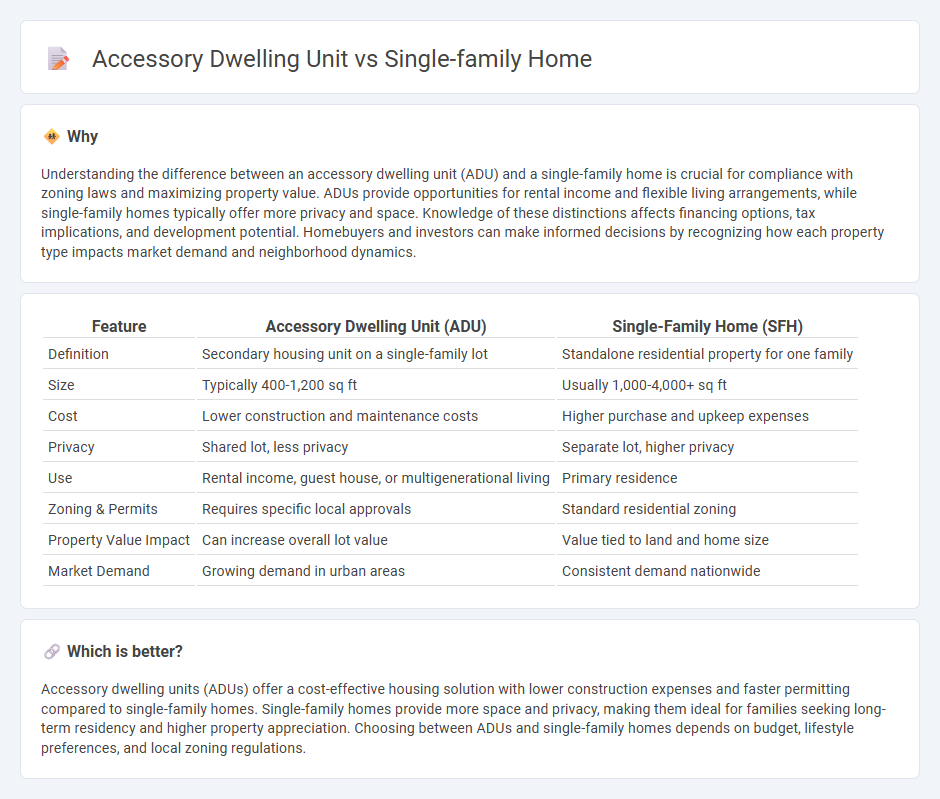
Accessory dwelling units (ADUs) offer flexible living spaces with lower construction costs and increased property value compared to traditional single-family homes. Single-family homes provide privacy and larger living areas but often come with higher purchase prices and maintenance expenses. Explore the benefits and drawbacks of ADUs versus single-family homes to make an informed real estate decision.
Why it is important
Understanding the difference between an accessory dwelling unit (ADU) and a single-family home is crucial for compliance with zoning laws and maximizing property value. ADUs provide opportunities for rental income and flexible living arrangements, while single-family homes typically offer more privacy and space. Knowledge of these distinctions affects financing options, tax implications, and development potential. Homebuyers and investors can make informed decisions by recognizing how each property type impacts market demand and neighborhood dynamics.
Comparison Table
| Feature | Accessory Dwelling Unit (ADU) | Single-Family Home (SFH) |
|---|---|---|
| Definition | Secondary housing unit on a single-family lot | Standalone residential property for one family |
| Size | Typically 400-1,200 sq ft | Usually 1,000-4,000+ sq ft |
| Cost | Lower construction and maintenance costs | Higher purchase and upkeep expenses |
| Privacy | Shared lot, less privacy | Separate lot, higher privacy |
| Use | Rental income, guest house, or multigenerational living | Primary residence |
| Zoning & Permits | Requires specific local approvals | Standard residential zoning |
| Property Value Impact | Can increase overall lot value | Value tied to land and home size |
| Market Demand | Growing demand in urban areas | Consistent demand nationwide |
Which is better?
Accessory dwelling units (ADUs) offer a cost-effective housing solution with lower construction expenses and faster permitting compared to single-family homes. Single-family homes provide more space and privacy, making them ideal for families seeking long-term residency and higher property appreciation. Choosing between ADUs and single-family homes depends on budget, lifestyle preferences, and local zoning regulations.
Connection
Accessory dwelling units (ADUs) are secondary housing units located on the same lot as a single-family home, enhancing property value and providing flexible living options. Integrating ADUs with single-family homes supports affordable housing development and maximizes land use in residential neighborhoods. Local zoning laws increasingly permit ADUs to address housing shortages while maintaining the character of single-family home communities.
Key Terms
Zoning
Zoning regulations critically impact the development of single-family homes and accessory dwelling units (ADUs), often dictating size, placement, and usage restrictions within residential areas. Municipal codes frequently allow ADUs to increase housing density without altering neighborhood character, promoting affordable housing options and efficient land use. Explore local zoning laws to understand how they affect property value and development potential.
Ownership
Ownership of single-family homes typically involves full control over the property and larger land area, providing privacy and investment opportunities. Accessory dwelling units (ADUs) often share ownership with the primary home, allowing for flexible use like rental income or multigenerational living. Explore the benefits and legal aspects of each ownership type to make an informed decision.
Occupancy
Single-family homes typically accommodate one household, offering private, exclusive living space, while accessory dwelling units (ADUs) provide flexible occupancy options by supporting additional residents on the same property, often ideal for multi-generational families or rental income. ADUs enhance housing density without altering neighborhood character, frequently addressing local housing shortages and zoning regulations. Explore more about occupancy benefits and regulations of ADUs to optimize your property usage.
Source and External Links
Single and One Story Homes in Austin, TX For Sale | Redfin - Single-family homes, specifically single-story, are widely available in Austin, TX, with a median listing price of $575K and diverse neighborhoods like Mueller and Tarrytown.
Single Family Homes For Sale in 78704, TX - Movoto - There are numerous single-family homes for sale in Austin's 78704 zip code with a range of sizes, prices, and new listings updated regularly.
Travis County TX Single Family Homes For Sale - 6956 Homes - Zillow - Travis County offers a large inventory of single-family homes across various price points and neighborhoods near Austin, ideal for buyers seeking variety and options.
 dowidth.com
dowidth.com